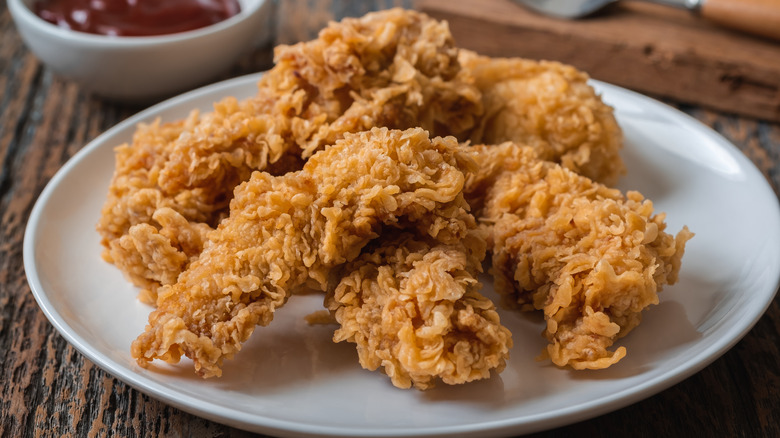The Exact Difference Between Chicken Tenders And Strips
There's something delightfully comforting about ordering a red, plastic basket of crispy chicken strips from your favorite dive. And if you're like most, you've probably not given a lot of thought to the difference between chicken tenders and chicken strips. Some menus have one listed, while others have the other. At the end of the day, it's an excellent deep-fried, juicy chicken vehicle for shoveling your favorite sauces into your gaping maw. Well, we're here to highlight the big difference between chicken tenders and chicken strips for when the dinner conversation potentially turns to this wildly nuanced question.
By far, the biggest difference between tenders and strips is which type of cut is used to make up the piece of chicken meat that you're eating. But differentiating between the two isn't always so easy. Some people use the terms chicken strips and chicken tenders interchangeably, which gets confusing quickly. Don't worry, we'll go through each so you'll know what to look out for and which you prefer.
What are chicken tenders?
Chicken tenders, short for chicken tenderloins, are thin strips of white meat that typically come from the underside of the breast. If you want to get technical, chicken tenders are made from the pectoralis minor muscles, which are found on either side of the chicken's chest, under the pectoralis major. This means that a total of two tenders can be harvested from each, individual chicken.
Some chefs differentiate tenderloins from tenders as being a bigger, hand-pulled piece of muscle, but at the end of the day, they come from the same place, they may just vary in size. Some people refer to chicken tenders as chicken fingers, but not all chicken fingers are made from the under-breast muscle, which means that while chicken tenders can be called chicken fingers, not all chicken fingers are classified as chicken tenders. The same goes for chicken strips and, yes, we're aware that it sounds like an impossible-to-solve poultry riddle.
Classic chicken tenders are served battered and fried and really live up to their nickname because, when prepared properly, they come out moist and, for lack of a better word, tender. Their ability to retain moisture and tenderness throughout the cooking process is what makes them a popular cut of meat to fry up. If you're looking for a healthier alternative to fried chicken tenders, consider baking them — you still get that crispy, juicy bite without the oil bath.
What are chicken strips?
Chicken strips are where things get confusing. Some people refer to chicken tenders as chicken strips because they're technically thin strips of meat that come from chickens. Other people refer to long and thin chicken patties as chicken strips simply because they're in a strip shape. Good & Gather, for example, sells a bag of "Crispy Chicken Breast Strips," which are described as "fritters with rib meat, made with white-meat chicken." This means that they're not even a whole cut of chicken but more of a patty.
To make matters even more confusing, there is a lot of debate on the internet over what technically constitutes a chicken strip. We turned to the United States Department of Agriculture to get some clarification on the matter. According to the USDA's Federal Purchase Program Specification, chicken strips are "produced from ready-to-cook boneless, skinless, marinated chicken meat of either white and dark meat, or all white meat." So the umbrella category as to what is technically a chicken strip is much larger.
The biggest difference is the chicken meat
Basically, the biggest difference is that — though size might vary — chicken tenders are always made from the pectoralis minor muscles, aka the white, rib meat featured under the breastbone. On the other hand, chicken strips can be formed from any part of the chicken, or even multiple parts of the chicken combined. Ultimately, one has a more flexible definition than the other.
So your decision between getting yourself some chicken tenders or some chicken strips largely comes down to what kind of meat you want to bite into. If it's important that you have one whole filet of tender, juicy white meat that came from beneath the chicken breast, then you'll want to order chicken tenders. If it doesn't matter to you what part of the chicken is hiding under that crispy, golden breading as long as it's moist and tastes delicious, then you should be safe ordering chicken strips.



